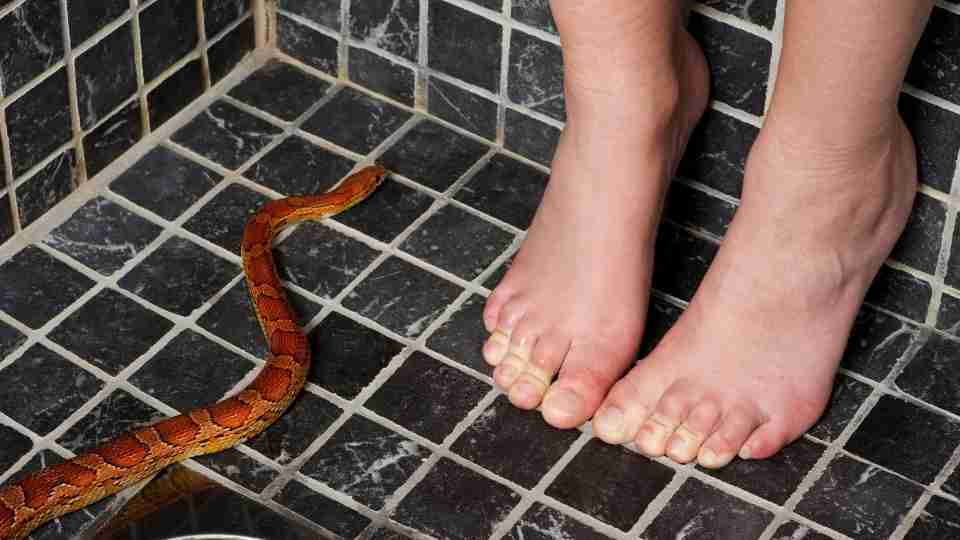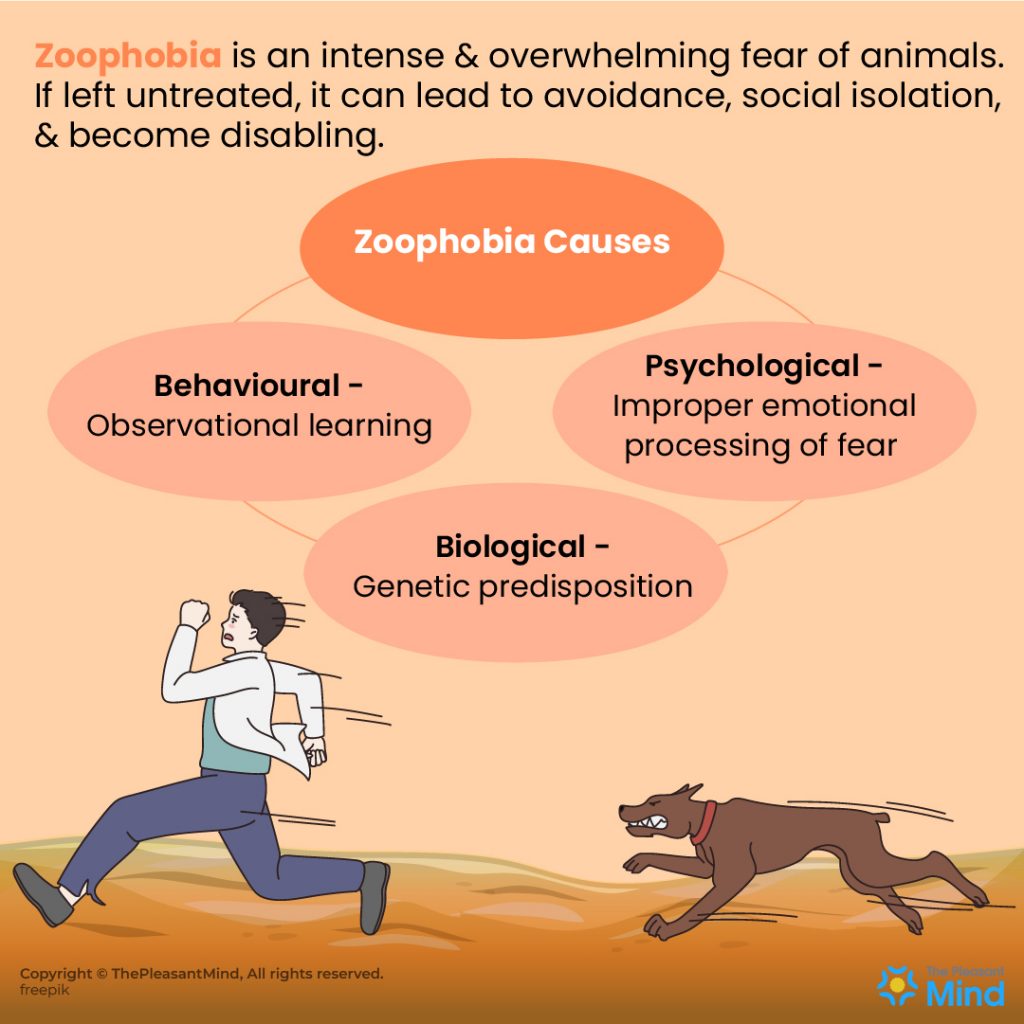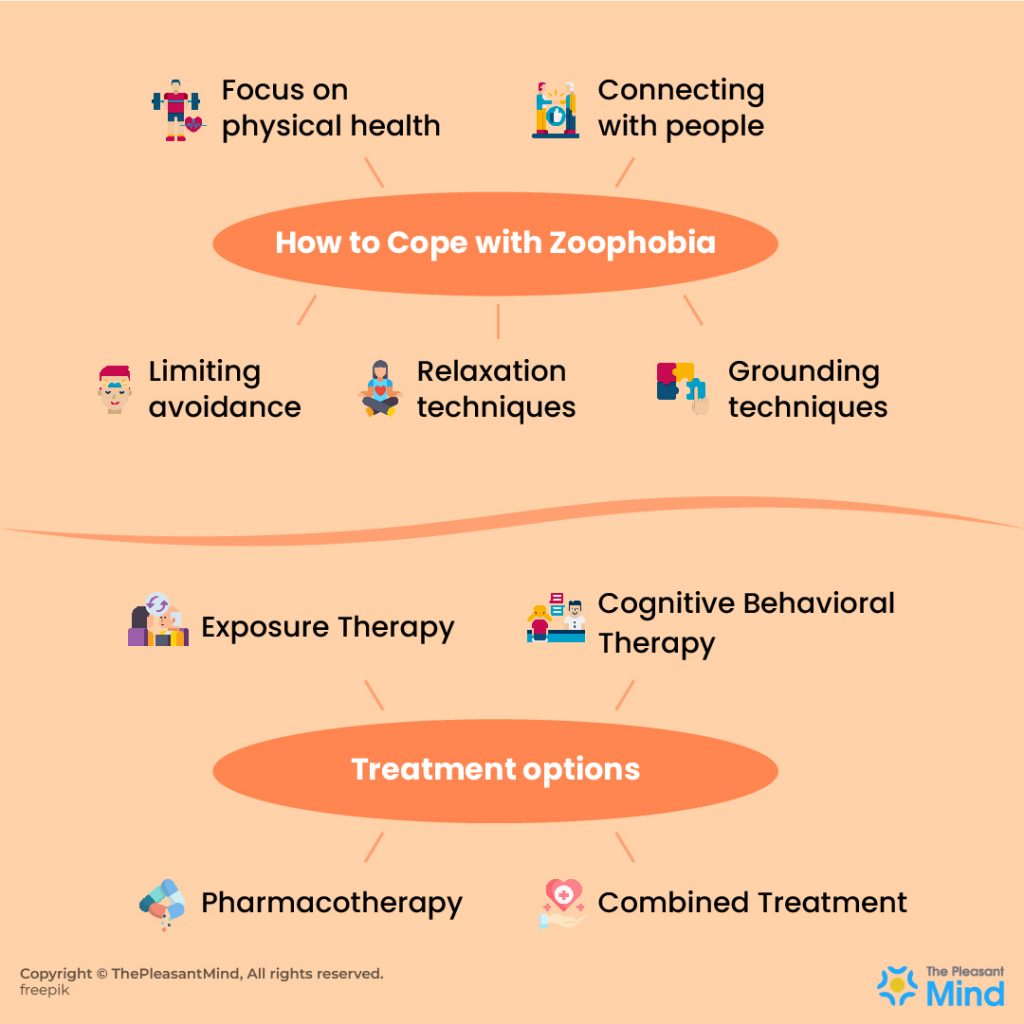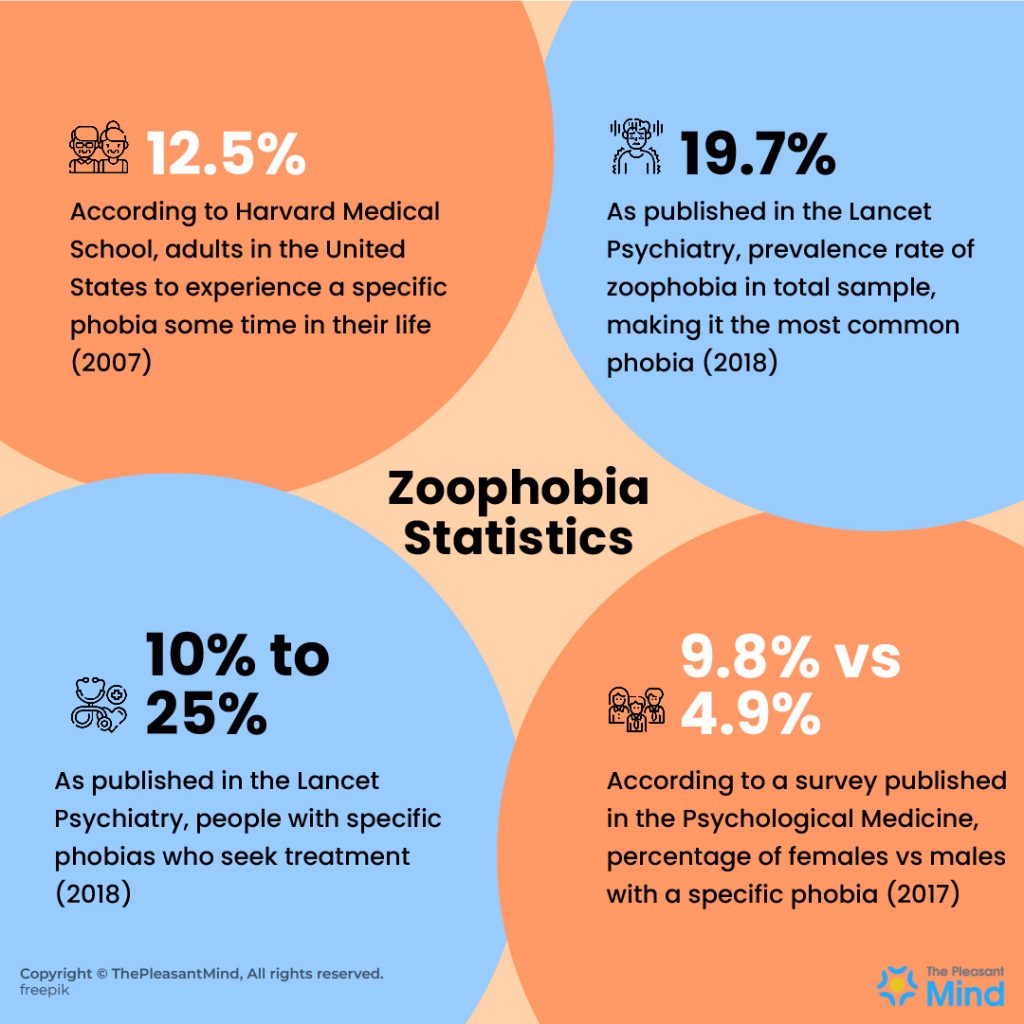
Key Takeaways
- Zoophobia is a type of specific phobia, wherein the sufferer experiences an intense fear of animals.
- The fear of animals can worsen over time in that it can turn into avoidance, isolation, and even clinically significant distress and impairment.
- There are various types of interventions available for the treatment of zoophobia.
- Exposure therapy is the primary and most common treatment option.
Zoophobia, not to be confused with the famous webcomic, is a type of specific phobia. It is an overwhelming and uncontrollable fear of animals.
It is a medically significant condition and can hinder functioning in various areas of an individual’s life.
Phobias fall under the category of anxiety disorders and can be debilitating for many. There are effective treatment options available. With that said, only 10-25% seek help.
Read on to understand more about this zoophobia. Having this knowledge can help you in identifying the early signs of such fears.
Consequently, it can help you, or someone you know, seek timely therapeutic intervention.
Zoophobia Infographics


Zoophobia (Fear of Animals)
SUMMARY
The fear of animals is known as zoophobia or animal phobia. It is an intense, uncontrollable, and persistent fear. Zoophobia is likely to cause profound distress and can decrease the individual’s quality of life.
A phobia in itself is an overwhelming fear of some specific thing or situation. The feared object, such as blood, needles, or animals, invoke intense anxiety in the person.
They experience fear that surpasses the actual threat posed by the object or situation.
It is said that 12.5% of adults in the US are likely to suffer from a specific phobia at some point in time in their lives.
Zoophobia Definition
The term zoophobia is a combination of zoo and phobia. “Zoo” relates to animals and is derived from the Greek word, zion. Meanwhile, “phobia” is derived from the Greek word, phobos, and means irrational fear.
Therefore, zoophobia, also known as animal phobia, is an intense and irrational fear of animals. Zoophobia is one type of specific phobia, which in turn falls under anxiety disorders.
Commonly, zoophobia is rather specific in nature. In other words, they are typically directed at a particular type of animal.
Sometimes, the individual may fear more than one kind of animal, including all animals.
The person who is suffering from zoophobia is typically aware that their feelings are irrational.
However, this fear is experienced as out of their control. If left untreated, these intense fears can worsen over time.
Zoophobia Symptoms
Individuals with zoophobia are likely to experience symptoms to varying degrees. It may range from mild to severe and such intensity is determined by how much these phobias affect your life.
Typically, these symptoms surface when the individual encounters the feared animal. However, in severe cases, they may experience these symptoms continually.
There are chances that they will be preoccupied with avoiding the animal they fear.
For instance, they may avoid watching nature documentaries or trips to the zoo. In extreme cases, people may resort to isolating themselves. They may worry about leaving their home owing to their fear of coming across this animal.
The primary symptom of any specific phobia is an intense fear of the object in question. In zoophobia, this feared object is one or more specific animals.
The noteworthy point is that the feared object is not threatening enough to substantiate the level of fear experienced.
Regarding zoophobia, the individuals feel overwhelmingly scared when they face the feared animal.
This doesn’t need to occur only in the physical presence of the animal. A person with zoophobia can experience such intense fear even while:
- Thinking of the animal
- Hearing about the animal
- Seeing the animal on media
- Talking about the animal
Apart from avoidance and a feeling of dread at the thought of the feared animal, people may experience physical symptoms.
Following is a list of common physical symptoms experienced by people with zoophobia.
- Light-headedness
- Trembling
- Increased heart rate
- Increased sweating
- Shortness of breath
- Nausea
- Tightness in chest
In children, these symptoms tend to manifest differently. Here are a few signs to look for in addition to those mentioned above.
- Excessive crying
- Freezing up
- Throwing tantrums
- Clinging behaviors
How to Identify Zoophobia
Zoophobia and other specific phobias are likely to intensify over time. It goes from fear to avoidance to a clinical diagnosis.
Most people are not diagnosed until their anxiety and avoidance cause intense distress and affect their lives.
Mental health professionals use the Diagnostic and Statistical Manual of Mental Disorders, 5th Edition (DSM-5) as a guide for diagnosing various conditions.
The criteria for specific phobia are as follows.
- Marked fear about a particular object or situation. (In the case of zoophobia, this specific object is an animal or a specific kind of animal.)
- The feared object (here, animals) almost always immediately evokes anxiety or fear.
- The fear or anxiety is disproportionate to the actual threat posed by the specific object and to the social and cultural context.
- The phobic object is met with avoidance or endurance with extreme fear and anxiety.
- The fear, anxiety, and avoidance cause significant distress and impair various areas of functioning.
- The fear, anxiety, and avoidance are persistent and last for 6 or more months.
- The distress is not better explained by the symptoms of another mental condition.
Also, the DSM-5 calls for specifying the type of specific phobia and includes a category for animals. People with zoophobia fall into this subtype.
To provide a clinical diagnosis, a mental health professional may administer a screening tool.
This assessment varies according to the types of animals feared. Typically, however, they merely ask you some questions, which are outlined below.
- Have you experienced such intense and irrational fear of a specific animal to the extent of avoidance?
- For how long have you experienced this fear?
- What are the physical and emotional sensations you experience when you encounter this animal?
- In what way has the resulting stress and anxiety affected you, socially and/or occupationally?
Fear of Animals: Phobia Types
There are various types of zoophobia depending on the animal feared. Here is a list of the names of specific phobias related to some common animals.
- Fear of amphibians – Batrachophobia
- Fear of arachnids – Arachnophobia
- Fear of bats – Chiroptophobia
- Fear of bees – Melissophobia
- Fear of birds – Ornithophobia
- Fear of butterflies – Lepidopterophobia
- Fear of cats – Ailurophobia
- Fear of cockroaches – Kastaridaphobia
- Fear of dogs – Cynophobia
- Fear of fish – Ichthyophobia
- Fear of frogs – Ranidaphobia
- Fear of horses – Equinophobia
- Fear of insects – Entomophobia
- Fear of lizards – Scoliodentosaurophobia
- Fear of maggots – Scoleciphobia
- Fear of mice or rats – Musophobia
- Fear of moths – Mottephobia
- Fear of shellfish – Ostraconophobia
- Fear of snakes – Ophidiophobia
- Fear of worms – Vermiphobia
Zoophobia Causes
Researchers are yet to find a definitive cause for specific phobias, including zoophobia. Following are some of the causes that could account for the development of zoophobia.
They are broadly categorized into behavioral, psychological, and biological causes.
1. Behavioral Causes
A person can develop fears, including zoophobia, through learned behaviors. For instance, an individual can learn to fear animals from someone close to them.
Typically, it is someone they look up to, such as an authority figure or a parent.
Such observational learning or modeling can lead to the development of fears. For example, if someone’s parent fears snakes, they may learn to fear the same.
2. Psychological Causes
Different people process anxieties and fears differently. Some individuals are likely to feel anxiety more intensely than others.
These people are more susceptible to developing phobias, including zoophobia.
Another psychological cause is related to the processing of negative or fearful experiences.
It is possible that an individual had unpleasant or scarring childhood experiences with an animal. In such cases, they are more likely to develop a fear of animals.
3. Biological Causes
Indeed, the precise cause of developing phobias continues to remain unclear. However, researchers believe that genetic predispositions are likely to play some role.
A twin study conducted in the year 2014 pointed to genetic risk factors for zoophobia. According to the researchers of this study, genetic factors of the phobias support the DSM-5 diagnoses of animal and blood-injection-injury phobias.
Additionally, this phobia is more common among women than men. 9.8% females suffer from zoophobia as against 4.9% males.
Ways to Cope with Zoophobia
Having read so much about zoophobia, you may be wondering how to cope with these fears and anxiety. For milder cases, the following ways can be a good place to start.
Keep in mind that these are merely self-help strategies and do not replace medical or professional assistance.
This set of tactics may at least help in the short term. For long-term benefits, it is important to reach out to a mental health professional.
1. Focus on physical well-being
Paying attention to keeping your body healthy can go a long way. Assess your nutrition, lifestyle, exercise regimen, and sleep. If you deem it maladaptive, consider working on these areas.
They will not cure your phobia, but they can help in reducing the intensity of symptoms experienced.
2. Relaxation techniques
Learning and practicing relaxation techniques can help reduce the stress associated with suffering from zoophobia.
For instance, you can incorporate yoga, breathing techniques, and meditation into your everyday routine.
When you experience fear and anxiety, you are likely to hyperventilate. In other words, you tend to take quick, shallow breaths.
This type of breathing is counterintuitive as it worsens the physical sensations of anxiety.
Abdominal breathing is effective as it helps to ease tense muscles and decrease shortness of breath. Therefore, this technique reverses the physical experience of anxiety.
3. Connecting with people
Suffering from zoophobia can be daunting and it is natural to feel like you are alone in this. However, the reality is that it is the most common specific phobia with a 19.7% prevalence rate.
So, joining support groups can help you feel less alone in this battle and might prove to be a safe haven.
Additionally, you may benefit from simply sharing your thoughts and feelings with people around you. Try not to refrain from connecting with and opening up to your friends and family.
Similarly, if your child is suffering from zoophobia, connect with them. Let them know that most people experience fearful thoughts sometimes, and for some, it can happen more often.
Be mindful to not trivialize their experience or disparage them for being terrified of animals.
Instead, talk to them openly about their thoughts, feelings, and experiences. Show them that you understand and are there to help in any way you can.
4. Limiting avoidance
You might force yourself to avoid activities that involve the possibility of an encounter with the feared animal.
This behavior only reinforces your zoophobia and you get into a vicious cycle of fear and avoidance. You can consider starting slowly.
5. Practise grounding techniques
Another way to relieve feelings of anxiety is to ground yourself. In other words, during such instances, you are drowning in anxious thoughts and feelings.
Focusing and engaging one or more of your senses can help you bring yourself back to the present.
Therefore, you can consider experimenting with various senses to understand which one brings the most relief. Here are a few examples of ways to engage each sensory modality.
- Sight – Look at something that might calm you, like a specific person, pictures and videos of puppies, or a scenic view.
- Hearing – Pay attention to the sounds around you, such as birds chirping, music, or people talking.
- Smell – Lighting fragrant candles, smelling your favorite perfume, or flowers from a garden are a few examples.
- Taste – Focus on the different flavor profiles that you can detect while having a meal. To do this effectively, slow down and savor each bite. Chewing gum is another example.
- Touch – Grab hold of something textural that you can find around you. You can also try hugging yourself or gently massage your head and neck.
- Movement – Flail your arms and legs, jump, run, or stretch your muscles. Pay attention to the sensations that arise with each movement.
When to Seek Professional Help
If your symptoms are overwhelming to the point of disruption of everyday life, you must consider seeking professional help.
A mental health professional, like a psychologist or a psychiatrist, can help you overcome this intense fear of animals.
It is a wise idea to reach out to a professional when your phobia starts affecting other areas of your life.
Specifically, interference with interpersonal relationships, social interactions, everyday activities, or occupational life calls for intervention.
Mental health professionals can help you by gaining insights into your symptoms and distress.
Accordingly, they come up with appropriate therapeutic interventions based on your unique needs and symptoms.
It is not necessary that you must reach out only when you experience your symptoms as disabling. Along with self-help strategies, seeking assistance from a medical professional can lead to significant improvements.
How to Overcome a Fear of Animals: Exposure Therapy
Exposure therapy is the most commonly used treatment for specific phobias, including zoophobia. In this form of intervention, you are gradually exposed to the feared animal.
It takes place in a controlled and safe environment where the professional is present.
Types Based on Pace
Exposure therapy can be categorized based on the way the treatment is paced. Following is an account of these variations.
1. Graded Exposure
Exposure therapy involves creating a hierarchy of your fears, from least to most threatening, with the help of your therapist.
The first few sessions entail exposure to the least anxiety-inducing stimulus. Gradually, you will work with your therapist to climb up the hierarchy.
For instance, let’s suppose that an individual struggles with a fear of spiders (arachnophobia).
The hierarchy of fears will likely look something like the one outlined below. It goes step by step from the least anxiety-provoking scenario to the most feared situation.
- Thinking about spiders
- Talking about spiders
- Looking at a pictorial representation of spiders
- Watching a video of spiders
- Being in the same room as a spider in a glass enclosure
- Touching a spider
- Letting a spider crawl on you
2. Flooding
In this technique, the fear hierarchy is carried out from the bottom to the top.
The therapist exposes the individual to the most feared situation first before working upward to the least feared.
3. Systematic desensitization
Depending on the case, exposure is combined with relaxation skills. It is important to note that the individual will first be taught relaxation exercises, such as breathing techniques.
These techniques help manage the feelings of anxiety that arise in the face of a phobic situation.
Using these along with the graded exposure will help the individual unlearn their fear responses.
Types Based on Method
It is possible to categorize exposure therapy differently. Each variant differs in the way the intervention is carried out.
| Type | Meaning |
| In Vivo Exposure | The method described above wherein the individual works with the feared object in real life is in vivo exposure. |
| Imaginal Exposure | This method entails vividly imagining the feared animal. |
| Virtual Reality Exposure | In certain cases, the mental health professional may use virtual reality technology for zoophobia. Sometimes, this procedure is more feasible than having the animal available during sessions. |
Advantages of Exposure Therapy
Exposure therapy is thought to be beneficial for the following reasons.
- Habituation – The intensity of symptoms of zoophobia decrease over time as people get more and more exposed to the feared animal.
- Self-Efficacy – It boosts the individual’s sense of mastery as exposure helps them feel more capable. Managing one’s anxiety in the face of the feared animal reinforces what one is capable of.
- Extinction – This therapeutic intervention weakens the associations established between the feared animal and bad results.
- Emotional processing – Exposure also allows individuals to relearn their beliefs around the feared animal. In turn, they become more at ease with the experience of fear in itself.
Other Treatment Options
Exposure therapy is the primary intervention option for the treatment of zoophobia. However, there are several other options available.
Your mental health professional may use one or more of these interventions based on your unique needs.
1. Cognitive Behavioral Therapy (CBT)
Often, mental health professionals provide Cognitive Behavioral Therapy as an adjunct to exposure therapy.
CBT is a type of behavioral therapy that focuses on modifying behaviors by changing irrational and maladaptive cognitive patterns.
In this form of therapy, the individual will work with their therapist to understand their negative patterns of thinking and feeling.
Upon gaining insights into these patterns, they will help reshape these beliefs. The aim of this therapy is to reduce fear.
Specifically, CBT aims to identify and modify irrational and distressing thoughts and beliefs. The therapist will help the individual develop a variety of skills.
These skills will help them recognize and replace such maladaptive patterns with more manageable ones.
It is common for individuals to suffer from more than one phobia. In such cases, they have an increased risk of developing other mood or anxiety disorders.
2. Pharmacotherapy
Pharmacotherapy refers to a type of intervention that involves the prescription of medication. Typically, it is not the treatment of choice for specific phobias.
However, there lies some evidence that it can be used as an adjunct with exposure therapy.
Most research has gone into studying the efficacy of a specific antibiotic, D-cycloserine. With that said, this drug has been studied for the treatment of other anxiety disorders and not specific phobias.
Additionally, there are a few effective medications for accompanying mood and anxiety disorders.
For depressive disorders, antidepressants like selective serotonin reuptake inhibitors (SSRIs) are effective.
Anti-anxiety medication is prescribed for anxiety disorders. Beta-blockers relieve some of the physical symptoms experienced with anxiety, like high blood pressure and increased heart rate. So do tranquilizers like benzodiazepines.
3. Combined Treatment
Depending on the intensity of the phobia and comorbidities, if any, the mental health professional may recommend a combination of interventions.
For instance, they may suggest exposure therapy along with CBT and medication.
Mental health professionals never take a one-size-fits-all approach with individuals.
Every therapeutic intervention is tailor-made according to the needs of the individual. They take into account several factors, including their unique symptoms, lifestyle, and preferences.
If you are suffering from zoophobia, remember to consult your physician about the underlying risks and benefits of various treatment options.
Zoophobia Statistics

Concluding Thoughts from ThePleasantMind
Zoophobia or animal phobia is an intense, overwhelming, and irrational fear of animals. It is experienced as uncontrollable.
Moreover, zoophobia can lead to avoidance, social isolation, and significant impairment of various areas of functioning.
There is no single definitive cause of zoophobia. Learned behavior, genetics, or the way one emotionally processes fear may play a role in the development of zoophobia.
With that said, there are several effective therapeutic interventions available for zoophobia.
The problem lies with people with zoophobia and other specific phobias hesitating to seek treatment. The fear in itself prevents them from reaching out.
However, individuals must remember that help is available and they do not have to wallow in their suffering.
Article Sources
1. https://www.apa.org/ptsd-guideline/patients-and-families/exposure-therapy
2. https://www.verywellhealth.com/zoophobia-definition-symptoms-causes-treatment-5207828
3. https://www.medicalnewstoday.com/articles/zoophobia
4. https://www.healthline.com/health/phobia-of-animals
Ananya Ramesh is a mental health professional with a master’s degree in clinical psychology. She has a profound interest in producing and refining content, specifically ones related to mental health and psychology. What began as casually penning down her musings back in school has grown into a successful freelance venture. Outside of work, Ananya is constantly looking to live a more sustainable lifestyle and minimize her carbon footprint. She also enjoys reading fiction and autobiographies, cooking, exercising, and sketching portraits.